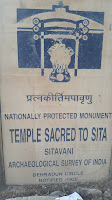SA Travel Diaries: Sitavani Temple, Nainital District, Uttrakhand by Aditi Joshi
Being a volunteer at Speaking Archaeology always comes with its perks (and responsibilities, if I may add). So, be it a vacation with family, camping with friends or casual outings, each location is nothing short of a historical site. If you get down to it, you might be lucky enough to catch up on the history.
 A trip to Jim Corbett sounds like a fun filled, adventurous outing. History is not something you expect to find there. Except that the area contains one of the most auspicious sites, so much so that it is a nationally protected monument under the Archaeological Survey of India. The site being discussed is the "Temple Sacred to Sita"- Sitavani.
A trip to Jim Corbett sounds like a fun filled, adventurous outing. History is not something you expect to find there. Except that the area contains one of the most auspicious sites, so much so that it is a nationally protected monument under the Archaeological Survey of India. The site being discussed is the "Temple Sacred to Sita"- Sitavani.
Getting up for an early morning safari in the National Park, I had slight idea about a temple we might visit. However, getting out from my daze I realised that the temple might have a historical relevance. And I was not disappointed here at all. The temple turned out to be an archaeological site!
 Happily I began to click pictures and hopefully meet the head priest who could help me with the history of this temple. There he was, getting ready for the morning prayers, collecting flowers from the campus and arranging them infront of the idols. He washed the premises, chanting incantations. Oh that moment! It was almost surreal. The sun peeped through the foliage, spreading its honeyed warmth all over; the fresh dew over the grass had a sweet fragrance of its own; the flowers and the lotus bed in the lake below just added to the aura of the Temple.
Happily I began to click pictures and hopefully meet the head priest who could help me with the history of this temple. There he was, getting ready for the morning prayers, collecting flowers from the campus and arranging them infront of the idols. He washed the premises, chanting incantations. Oh that moment! It was almost surreal. The sun peeped through the foliage, spreading its honeyed warmth all over; the fresh dew over the grass had a sweet fragrance of its own; the flowers and the lotus bed in the lake below just added to the aura of the Temple. Owing to the prayers hosted by an influencial family of the area, the priest could not devote much to quench my queries. That, however, gives me a perfect excuse to come here again!
Owing to the prayers hosted by an influencial family of the area, the priest could not devote much to quench my queries. That, however, gives me a perfect excuse to come here again!
The temple was very auspicious to Sita, the wife of the Hindu God, Rama. There is also an idol of Nandi, Lord Shiva's Bull, and a Shiva Linga which further prove Sita's devotion for Pashupati (another name for Lord Shiva). Apart from the Shiva Linga and Nandi, the other idols have been established during a later period. The temple complex has been left in its original form to preserve its character. Therefore, no cementing of the main complex has been observed and this makes one marvel at the architecture and construction skills of the era gone by!
As the crowd streamed in for the scheduled prayers, we decided it best to return for we had a number of safari sites lined in for the day. The sun was already high up and we were sure to find no wildlife now on our way back (but we did! It was a group of deer. True that the thrill was not the same as catching sight of a tiger but still, they were pretty posers and quite photogenic to say the least!)
My romance with the place was short lived, but worth it, so much so that I promised to come back again just to catch up on the lost history of the site. I shall not let the forgotten history become a forgotten culture. After all, I am a Speaking Archaeologically Volunteer!



Comments
Post a Comment